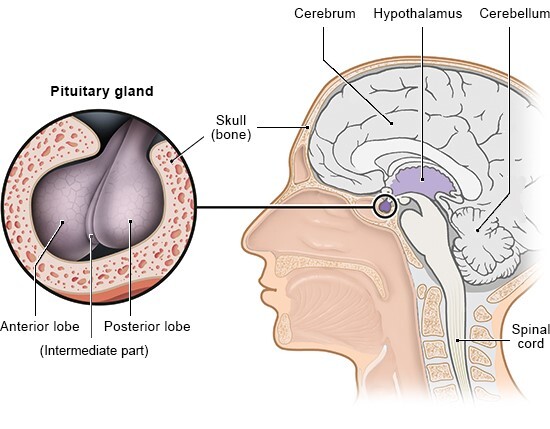NCBI Bookshelf. A service of the National Library of Medicine, National Institutes of Health.
InformedHealth.org [Internet]. Cologne, Germany: Institute for Quality and Efficiency in Health Care (IQWiG); 2006-.
The pituitary gland is about the size of a pea or cherry, and hangs down from the main part of the brain. It regulates various body functions and plays an important role in controlling hormone levels in the body.
The pituitary gland does that by making a number of hormones that either regulate most of the other hormone-producing glands in the body or have a direct effect on specific organs. It also controls the involuntary (vegetative) nervous system. This part of the nervous system manages the balance of energy, heat and water in the body, which includes things like body temperature, heartbeat, urination, sleep, hunger and thirst. The hypothalamus, a part of the brain, also helps to do these two jobs.
The pituitary gland lies well protected in a small bony cavity of the skull, roughly in the middle of the head, behind where the eyes are. It is made up of four parts, each with their own functions:
- Anterior lobe
- Posterior lobe
- The area between the two lobes (the intermediate part, or "pars intermedia")
- Pituitary stalk: connects the pituitary gland to the hypothalamus

The pituitary gland: Location and individual parts
What does the anterior lobe do?
The anterior (front) lobe makes up about three quarters of the overall mass of the pituitary gland. It produces two kinds of hormones:
- Hormones that control other hormone-producing glands
- Hormones that have a direct effect on the body
The hormones that control glands include:
- Thyroid-stimulating hormone (TSH): affects the thyroid gland.
- Adrenocorticotropic hormone (ACTH): stimulates the adrenal glands
The hormones that have a direct effect include:
- Growth hormone (GH), also called somatotropic hormone (STH): stimulates the growth of bone, muscles and organs and also helps the building blocks and energy needed for that to be prepared in the liver
- Prolactin: stimulates the growth of girls’ mammary glands in puberty, suppresses ovulation in pregnant women, and triggers the production of breast milk after giving birth
The hormones are released into the bloodstream by the pituitary gland and then travel through the blood vessels until they reach the organs they have an effect on.
The production of hormones in the anterior lobe itself is regulated in two ways:
- Through the hypothalamus, which makes hormones (known as “releasing hormones”) that increase the production of hormones in the anterior lobe, or hormones (known as “inhibiting hormones”) that reduce it.
- Through hormone levels in the blood: TSH, for example, stimulates the thyroid gland to increase or reduce the production of thyroid hormones, depending on how much is needed. If the level of thyroid hormones in the bloodstream is high enough, the pituitary gland will stop making TSH. This works the other way round, too: If the level of thyroid hormones is too low, the pituitary gland and hypothalamus make more TSH. The thyroid gland then produces more thyroid hormones.
What does the posterior lobe do?
The posterior lobe of the pituitary gland mainly consists of nerve fibers coming from the hypothalamus. The hormones that are made by these nerves are stored in the posterior lobe. They are released if needed:
- Oxytocin: affects the womb and mammary glands, and causes contractions in childbirth, for instance.
- Antidiuretic hormone (ADH): regulates water uptake in the kidneys and makes the blood vessels narrower. This can increase blood pressure.
The posterior lobe of the pituitary gland is directly connected to the hypothalamus through the pituitary stalk.
What happens in the intermediate lobe?
The tissue between the anterior and posterior lobes also makes hormones. Melanocyte-stimulating hormones (MSH) are produced in this intermediate lobe. They stimulate the production of things like melanin in the skin. Melanin is a pigment that protects against harmful ultraviolet sun rays. MSH also controls our appetite and affects our sex drive.
Sources
- Brandes R, Lang F, Schmidt R. Physiologie des Menschen: mit Pathophysiologie. Berlin: Springer; 2019.
- Lippert H. Lehrbuch Anatomie. München: Urban und Fischer; 2020.
- Menche N. Biologie Anatomie Physiologie. München: Urban und Fischer; 2023.
- Pschyrembel Online. 2024.
IQWiG health information is written with the aim of helping people understand the advantages and disadvantages of the main treatment options and health care services.
Because IQWiG is a German institute, some of the information provided here is specific to the German health care system. The suitability of any of the described options in an individual case can be determined by talking to a doctor. informedhealth.org can provide support for talks with doctors and other medical professionals, but cannot replace them. We do not offer individual consultations.
Our information is based on the results of good-quality studies. It is written by a team of health care professionals, scientists and editors, and reviewed by external experts. You can find a detailed description of how our health information is produced and updated in our methods.
- In brief: How does the pituitary gland work? - InformedHealth.orgIn brief: How does the pituitary gland work? - InformedHealth.org
- BioProject Links for Protein (Select 2714150147) (1)BioProject
- IS200/IS605 family accessory protein TnpB-related protein [Bacillus sp. FSL K6-0...IS200/IS605 family accessory protein TnpB-related protein [Bacillus sp. FSL K6-0069]gi|2714149924|ref|WP_340844114.1|Protein
Your browsing activity is empty.
Activity recording is turned off.
See more...
